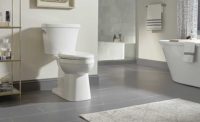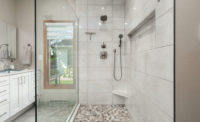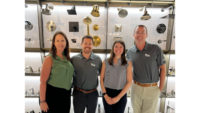There’s a shift happening in showrooms, and experts say it’s not about competing with the internet, it’s about offering an experience that can’t be matched by online shopping.
“For a while, we were displaying as much product as we can, but the truth is you will never display as much as the internet,” says Jeremy Smith, co-owner and direct of showrooms for Central Arizona Supply. “Your goal is to edit displays to be the most relevant to your client base, while at the same time having some level of inspiration. It is the adage of less is more.”
Charleston, South Carolina-based Gateway Supply also values interchangeability with its displays. “Quality of product and customer service are always the focus in showrooms, but keeping product up-to-date and having the latest and greatest displayed is why customers keep coming back,” says Aimee Williams Garrett, director of showrooms and marketing at Gateway. “So, it is important to have displays that are easily interchangeable and displays that are fully functioning so we can offer our customers a hands-on experience with different spray patterns before purchasing.”
After surveying some members, Luxury Products Group (LPG) shares that the next generation of consumers is after a well-lit, functioning vignette.
“The best part of shopping in person is seeing and touching the product with confidence in the product's functionality. When combining a running faucet, matching sink, tile backsplash and decorative pendant hanging above, you’re helping customers make faster decisions and enhance showroom sales,” explains LPG Director of Marketing Leigha Lugo.
Lugo emphasizes the importance of helping customers narrow down their selections. “An organized variety of brands is key, but with limited menu selection. By limiting selection, I find it’s easier to make a purchase decision when presented with a brand’s top sellers in no more than one to three finishes depending on whether we’re talking decorative lighting versus plumbing versus cabinetry,” she says. “It’s also helpful to be provided with a color palette of real metal swatches to see all available finishes in their true shade.”
Displays are also getting bigger, according to Consolidated Supply Co.’s Corporate Showroom Manager Amy Mack.
“I see displays moving away from slot walls and going to six-to-12-foot freestanding displays,” Mack says. “It’s still all about relationships, too. The more extensive of a trusted relationship we have with our vendors, the more inclined they are to invest in our particular showroom displays.”
When it comes to post-pandemic showroom business, pros agree that technology — both in new products and showroom operations — is the forefront trend.
“The biggest changes of showroom displays post-pandemic is the incorporation of technology. It’s a game-changer to walk around the showroom with a representative who has an iPad to easily create a wish list or quickly write an order,” Lugo says. “On the other hand, incorporating a QR code can allow customers to walk freely and gain knowledge of products if they choose to peruse the showroom alone.”
Touchless is still all the rage, but showroom managers say voice command is growing in popularity as well.
“Working displays are still really important, but I see displays leaning towards showcasing the voice activation technology on the market,” Mack says. “Alexa-activated showers, hands-free toilets — any of that smart home technology is great to have showcased in the showroom.”
Color schemes are also shifting from the popular white and neutral design from the past several years.
“I like to have a pop of color in the showroom; a colored tub or powder-coated faucets — items in the showroom that are easy to switch out,” Mack explains. “It doesn’t necessarily mean the customer will buy that color, but it starts the conversation where we can tell them all of the finishes available.”
Again, Lugo points out having displays that are easily switched out is key. “The strategy is overall to have a 25% rotation of displays annually and measure the ROI of a display using your sales history. The bottom line is if it's not selling, get it off the floor,” she says. “However, at a time where it may be difficult for some showrooms to receive new displays, a great way to keep a showroom looking fresh would be to rotate product placement. Another way could be to place attractive colors and textures at the end of pathways to encourage and create guided exploration.”
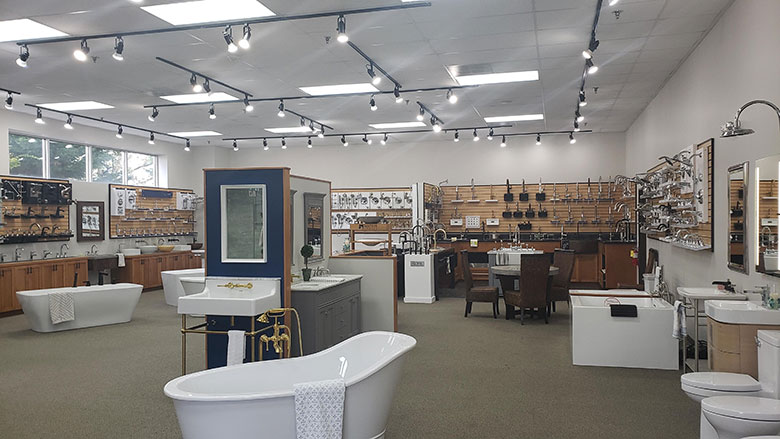
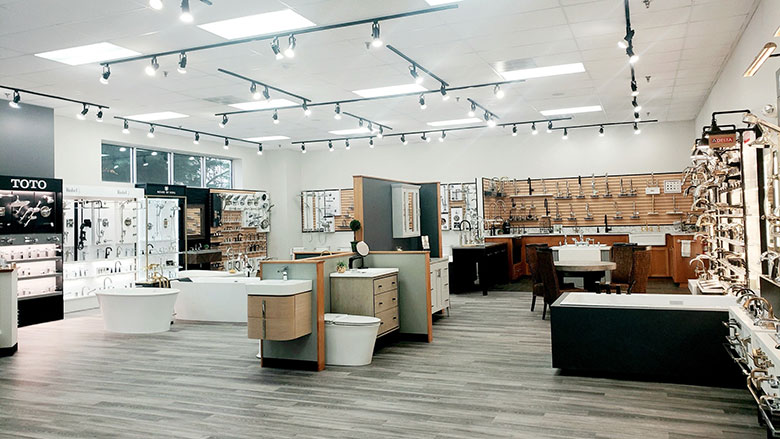
Foot traffic and digital presence
Offering a value-added customer experience starts as soon as the customer walks in the door. Gateway’s William’s Garret says foot traffic has been incredible in her market, and the company is focused heavily on brand marketing.
Smith says with current supply chain disruption, Central Arizona Supply is actually trying to slow down foot traffic right now. “I know that sounds strange being that we are in the business of making sales, but we are requiring appointments and working with more of the trade than the consumer. We are trying to focus on longer-term projects that have time to wait for product,” he says. “Contractors are doing a better job of ordering earlier and keeping the client on track. Consumers, on the other hand, have heard about supply chain disruptions and feel like giving you an extra couple of weeks is all they need, which is just not attainable.”
Mack shares that Consolidated’s showrooms — The Fixture Gallery — use an app to keep track of foot traffic. “Every time someone walks in, our team selects whether they’re a builder, homeowner, designer, etc.,” she says. “That way, we can review and see who is visiting us and know specifically what group to focus on reaching out to the next month.”
For showrooms looking to boost foot traffic, Lugo advises finding creative ways to work with the local community and suppliers.
“Work with suppliers on events that drive awareness for a cause or celebrate with late-night networking events by inviting local businesses and designers and promote one another,” she says. “An awesome example is LPG member, Waterhouse Bath and Kitchen Design Studio. For World Toilet Day, Amy Siders, showroom manager, raised awareness about this important day by working with suppliers to donate toilets to be painted by local art students. This unique idea promoted the showroom, suppliers and community, and together made a bigger difference. Don’t be afraid to rally for a relevant cause to the showroom’s industry and send press releases to those local networks.”
Although foot traffic in the decorative plumbing space is always important, showroom professionals know digital presence is vital in today’s market as well.
Mack says social media has been a great tool in growing The Fixture Gallery’s online footprint. “We recently launched a social media campaign on Twitter, Facebook, Instagram and LinkedIn where we make short — about 30-second — videos of our staff featuring a product,” she says.
Smith agrees that social media is a great tool for showrooms. “We’re active on social media and we work to make sure the website stays up-to-date,” he says. “The ability for potential clients to make an appointment online is huge. If we can get them to book an appointment, we turn that quote into a sale 95% of the time.”
Lugo says LPG encourages its members to have a strong website and take advantage of Google’s capabilities. “Having a website is vital. Additionally, Google is a powerful tool. If I’m looking for a local business, I’m quick to search Google for location and reviews. It’s important to tap into the power of SEO and get your business to the forefront of your competitors and big box stores,” she says. “Local showrooms will always provide better customer service and a more personalized experience with a far better variety of brands and products to offer than any big box store. Reviews are vital for generations currently buying homes and doing the most renovations.”
Lugo adds that on way to prompt reviews is with customer incentives or discounts. When talking social media, she explains each channel has different strengths. “Facebook is great for groups and events, while Instagram is great for showcasing products and going live to talk about new showroom updates. Finally posting boards on Pinterest and linking back to your website is one of the best ways to stay relevant with home design inspiration as new homeowners devise renovation plans.”
Much more to come
As showroom displays evolve to match current consumer desires and design trends, one thing is for certain — product and internal operations technology will continue to advance.
“We live in a world where screen-time is significantly higher than our face-time with other humans. Interactive touch screens built into displays will prove to be helpful for most customers who prefer to peruse a showroom or for those designers who would like to view design inspiration and product details,” Lugo explains. “For the contractor who needs quick answers, these digital displays can provide spec information and quantities remaining, or even installation videos that can be forwarded to your phone with Bluetooth technology. QR codes may be here for a while and I hope to see more showrooms utilize these in a concealed way within the physical display for quicker order writing.”
Williams Garrett summarizes technology in the decorative space well: “Technology has been the main focus of manufactures in the bath and kitchen industry and it will continue to be a focus as our world revolves around technology today. Who would have imagined years ago that we would be selling fixtures controlled by voice command? Things are only going to advance from here and showrooms will continue to provide beautiful displays and a customized, valuable customer design experience.



